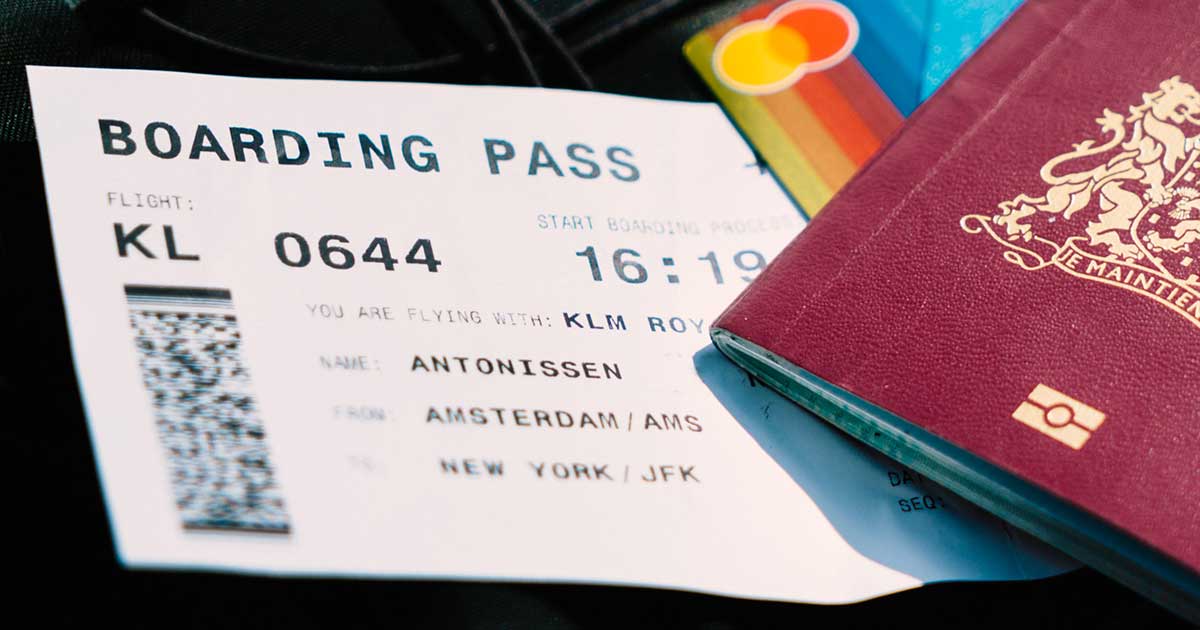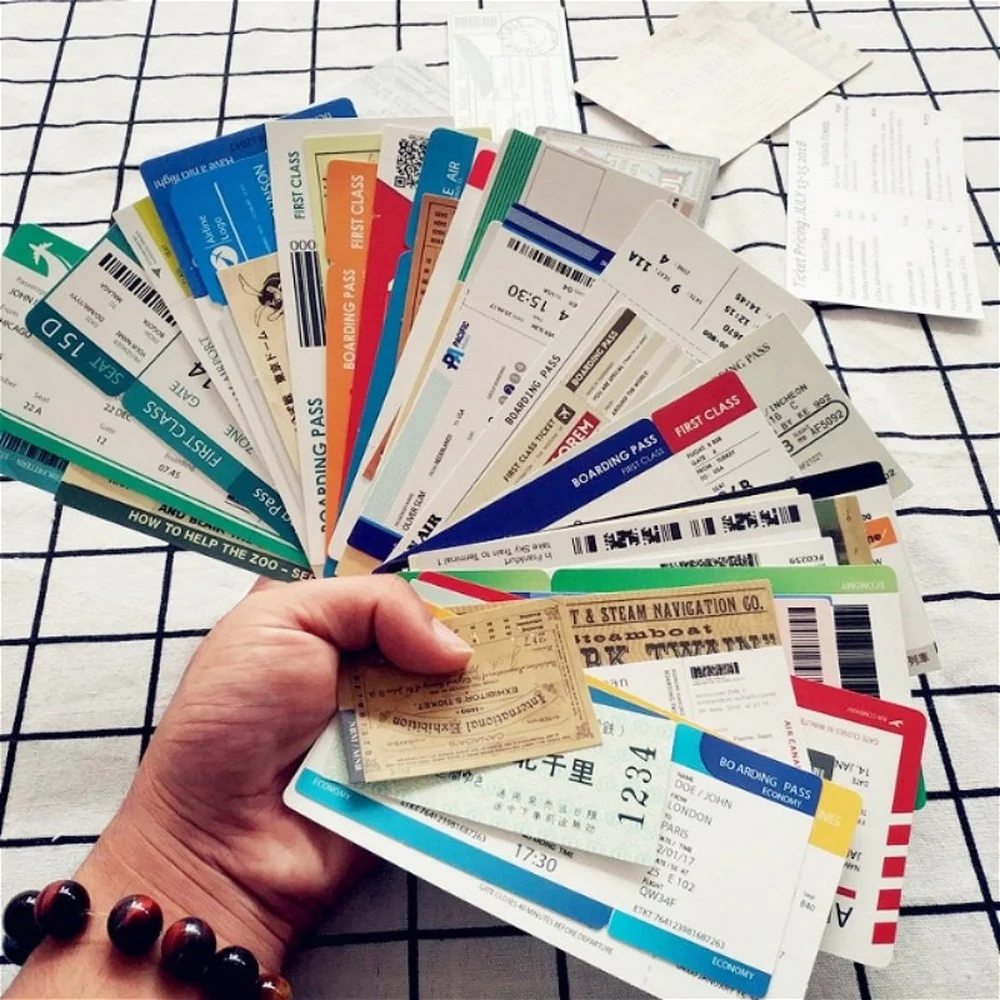Airline Decides To Phase Out Paper Boarding Passes - Saying Goodbye To Tradition
An airline decides to phase out paper boarding passes. In the age of digitalization and electronic ticketing, paper boarding passes might seem like relics of the past. However, these tangible pieces of paper play a crucial role in the air travel experience, ensuring a seamless transition from the airport terminal to the aircraft.
Author:Jane RestureSep 21, 20237.6K Shares212K Views

An airline decides to phase out paper boarding passes. In the age of digitalization and electronic ticketing, paper boarding passes might seem like relics of the past. However, these tangible pieces of paper play a crucial role in the air travelexperience, ensuring a seamless transition from the airport terminal to the aircraft.
A paper boarding pass is a tangible document provided by an airline that functions as an official permit for a passenger to embark on a designated aircraft. The boarding pass often includes crucial facts such as the passenger's name, flight particulars (comprising the flight number, departure and arrival locations, and departure time), seat allocation, and a scannable barcode.
However, in a recent development, Emirates has implemented a new policy requiring the majority of its passengers departing from Dubai International Airport to employ mobile boarding passes instead of conventional paper ones.
According to the official statement released by the company:
“„This initiative will significantly reduce paper waste while simultaneously offering a convenient and speedy digitized check-in experience for passengers departing Dubai. It reduces the risk of lost or misplaced boarding passes, giving passengers peace of mind when traveling.- Emirates
Emirates passengers who choose in-person check-in at the airline's principal hub in Dubai, Terminal 3, will now receive a mobile boarding pass by email or text message, rather than a standard paper pass.
Individuals who utilize the online check-in service will be able to obtain their boarding cards via the Emirates app, with the option of saving them in either Apple Wallet or Google Wallet.
Furthermore, the app will display checked luggage receipts, which are often given and delivered to travelers when they deposit their bags, or these receipts may be sent to the passenger through email.
The mobile boarding pass is acceptable at various points, including security clearance, airplane boarding, and shopping at Dubai Duty-Free. To ease this procedure, agents may quickly scan the QR code.
According to the airline, this change is meant to be a progressive step in its attempts to give passengers the ease and confidence that digitally assisted travel experiences bring.
Naturally, the bold choice raises concerns about a number of digital disruptions, for which Emirates expresses sympathy.
Individuals can request a physical pass from an Emirates agent in the event of various technological challenges such as a depleted phone battery, inability to connect to Wi-Fi, difficulties accessing a phone network or international data package, delays in pass delivery, or system glitches.
The airline is aware that physical boarding permits will be required in some cases, notably for passengers flying to the United States.
History Of The Boarding Pass
Boarding passesare an integral part of air travel in today's fast-paced world. They let people on the plane, tell them when the plane is taking off, and what time it will land, and make sure everyone has a good experience getting from the terminal to the plane.
The history of the seemingly little boarding pass, however, is rich with interesting technological developments and novel adaptations.
The Ticket Jacket
Passengers used to receive their tickets in ticket jackets before the invention of contemporary boarding cards. Passenger names, flight numbers, departure and destination cities, and departure times were all printed on plain paper and enclosed in these jackets.
Because of its dual use as a ticket and a means of keeping track of passengers, the ticket jacket might be seen as a forerunner of the modern boarding pass. At numerous stages in the trip, including check-in and boarding, passengers were required to show their ticket jackets as identification.
Using Sticky Tabs And Seat Numbers
In the 1960s, airlines began providing passengers with assigned seats to speed up the boarding process and make it easier for everyone to find their way to their seats. Passengers would be given stickers or adhesive tabs to place on their bags or clothing to designate their allotted seating location.
While this method did have some success, it was not perfect. Occasionally, boarding would be delayed because passengers couldn't find their seat stickers. In spite of this, the introduction of assigned seating was a huge improvement in the efficiency of air travel.
Separate Boarding Pass
In the 1960s, airlines began requiring passengers to present a separate boarding permit in addition to their ticket. The efficiency and orderliness of boarding were vastly enhanced by this new development.
Important flight details such as the passenger's name, seat number, boarding gate, and departure time were often printed on a separate boarding card. Now that passengers had a document created exclusively for boarding the plane, check-in and boarding went more quickly and efficiently.
Computer-Printed Passes
The advent of computer-printed boarding permits in the airline industry marked a technical sea change in the mid-1970s. With this new technology, airlines could issue boarding permits to passengers more swiftly and reliably, which improved efficiency and decreased the likelihood of mistakes.
It was a huge step forward for passenger ticketing and boarding procedures when airlines began using computer-printed boarding cards instead of handwritten or manually processed tickets.
Southwest's Color-Coded Plastic Boarding Passes
Southwest Airlines, known for its forward-thinking, was the first airline to use plastic boarding cards in different colors. The varying colors of these passes indicated different boarding categories or priority levels.
Passengers and airline employees both appreciated the extra flair that came from using color-coded plastic boarding permits to keep track of their respective boarding groups. This forward-thinking method illustrated how boarding passes may be modified to improve a certain airline's internal processes.
Magnetic Stripe Added To Tickets
A major improvement in airline boarding permits was made in 1983 when airlines began merging the ticket and boarding cards into a single document. Airport workers could quickly and easily scan these tickets because of the magnetic stripe on the back.
Simplifying the check-in process and paving the door for widespread electronic data integration across the airline sector are two benefits of merging ticketing and boarding information. By eliminating the need for both paper tickets and boarding permits, the travel process was simplified for passengers.
Scannable Barcodes
Using two-dimensional barcodes on boarding permits became mandatory once they were standardized in 2005 by the International Air Transport Association (IATA). The advancement was a giant step forward for data storage and safety.
Passenger and flight information were only two examples of the types of data that may be encoded in two-dimensional barcodes and then read at numerous locations throughout the airport. The safety and comfort of the passengers were also improved by this innovation.
Electronic Tickets
The widespread acceptance of electronic tickets, or e-tickets, marked the final stage in the development of boarding passes. The International Air Transport Association (IATA) stated in 2008 that all tickets were issued electronically.
Paper tickets and boarding cards are no longer necessary thanks to the advent of electronic tickets. Passengers may now use their mobile devices or printed tickets to board the flight. This sea change was a watershed moment in the airline industry's push toward modernity, which ultimately benefited passengers and the planet.
Mobile Check-In By Continental Airlines
As an industry leader in adopting new technologies, Continental Airlines was among the first to test out mobile check-in in 2007. With this revolutionary change, travelers could use their cell phones to check in for flights, acquire mobile boarding cards, and board planes without having to deal with paper tickets.
The introduction of mobile check-in completely changed the way people traveled, making it more convenient and less time-consuming for them to get on a plane.
What People Feel About Boarding Passes
For some individuals who enjoy travel, an airline-issued paper boarding pass holds significance beyond its function as a navigational tool to ensure timely arrival at the designated airplane seat.
The potential elimination of boarding passes as keepsakes may be disheartening for individuals who like to save them for sentimental purposes.
“„The boarding pass just adds something to these memories. That flight was more than just another trip on a thing with wings, it was somehow special.- Hartveldt
A traveler from the Philippines also said:
“„Coming from a developing country where travel, especially abroad, is a privilege, it gives a sense of pride. I felt air travel is a luxury because I only got to do it when I started working. When I was younger, we could only afford road trips. When I started traveling because of work, it also gave my parents a sense of pride. They worked hard to give me a good education. I kept the boarding passes from those trips.- Abi Cruz
Another individual from State College, Pennsylvania, USA stated:
“„I save the ones from unusual routes, especially those between airports in faraway places that I once didn't anticipate a reason to visit. I imagine a younger version of me looking at them and wondering, “Why will I be on that flight?”- Shomir Wilson
A traveler from Chattanooga, Tennessee, USA said:
“„The airline visits to each of my children's college campuses are two of the ones I have saved. I think looking at those and remembering all the excitement of starting that part of their life journey will be impactful as they grow older.- Shawn Arrington
In addition, someone from Frisco, Texas, USA commented:
“„To me it's a literal rite of passage. When I travel now with my wife and three boys I always opt to print. I love seeing the sense of responsibility in my 14-, 12 - and 8-year-old boys as they get to keep it safe, show it at TSA, then again at the gate check-in. I let them keep their passports for that too to make sure they learn the protocols of travel so when they grow up to travel alone, I don't need to worry if they will know what to do. I collected boarding passes in my early stage of my career because as a Pakistani immigrant to the USA of humble beginnings, it gave me a sense of accomplishment.- Khurram Baloch
A man from Acton, Massachusetts, USA also said:
“„I still have the boarding pass of the flight I took when I moved to the US as a graduate student about 25 years ago. An Air India flight, direct from Mumbai to Chicago. It was my first time in the US. I have been a US resident ever since.- Rahul Ponniah
Also, a traveler from Donegal, Ireland:
“„I have kept several boarding cards from my first ever trips to the USA from my home in Ireland as a teenager, I went to visit my pen pal and we have been friends for nearly 40 years!- Niamh Coughlan
Importance Of Paper Boarding Passes
The authorization to board a certain flight is shown on a paper boarding pass given by the airline. Details such as the passenger's name, flight number, departure city, arrival city, and departure time, as well as their assigned seat and a scannable barcode, are generally included.
- Accessibility - Although electronic boarding permits are on the rise in popularity, travelers with limited computer skills or no smartphone can still use traditional paper boarding tickets. This diversity protects the right of all passengers, especially those without cell phones or with other technological hurdles, to take advantage of air travel.
- Reliability - When technological gadgets fail, passengers can always rely on their paper boarding cards. A printed boarding card, for instance, is a backup plan in case a passenger's smartphone battery dies or experiences some other technical difficulty before their trip.
- Tangible Record- Passengers get a physical memento of their flight thanks to paper boarding tickets. This tangible token might serve as a remembrance, a recall of an exciting experience, or as documentation of travel costs when filing for reimbursement.
- Safety - Barcodes on paper boarding tickets allow airport workers to quickly and efficiently verify passenger information. By verifying a passenger's identity and boarding privileges with a barcode, security is improved. The increased safety of air travel is a result of this additional safety measure.
- Efficiency - Paper boarding cards are an efficient tool for airline and airport personnel to use in controlling the boarding procedure. They can be scanned and processed rapidly, making boarding easier for customers and airline staff alike.
- Redundancy - There is a backup plan in the form of paper boarding permits that airlines may use in the case of a problem with their computerized check-in systems. This backup system is essential for safe aircraft operations.
- Compatibility - Paper boarding cards are compatible with all airport and airline systems. They are a sensible option for airlines of any size or location due to their easy incorporation into preexisting airport infrastructure.
- International Travel- Paper boarding passes serve as vital papers for entrance and departure immigration formalities for foreign passengers. Their significance in international air travel is further highlighted by the fact that they may be used to fulfill visa requirements in certain countries.
Frequently Asked Questions
Are Paper Boarding Passes Still Necessary In The Era Of Electronic Ticketing And Mobile Check-in?
Paper boarding cards are still widely used because of the convenience, security, and dependability they provide to airline passengers. Paper boarding permits are still used to guarantee that passengers may board their aircraft in the event that electronic means fail.
How Do I Obtain A Paper Boarding Pass If I've Checked In Online Or At A Kiosk?
You may usually get a printed boarding pass at the airline counter or a self-service kiosk at the airport if you've already checked in online or via a kiosk. After completing an online check-in procedure with some airlines, you may be given the opportunity to print your boarding pass from home.
Are There Any Specific Regulations Or Requirements Regarding The Presentation Of Paper Boarding Passes During International Travel?
In some cases, such as when going through immigration and customs, overseas travelers are required to provide their printed boarding tickets. For a trouble-free foreign trip, research the local customs of both your departure and arrival nations.
Final Words
There are various reactions after people hear the newsthat an airline has decided to phase out paper boarding passes. The evolution of boarding cards is indicative of the airline industry's commitment to change and improvement.
Boarding passes have come a long way from its paper ticket jacket and sticky tab roots of the 1960s, to the digital revolution of e-tickets and smartphone check-in in the 21st century.
We can only speculate about the impact that future technological developments will have on onboarding permits, but one thing is certain: they will remain an integral part of the dynamic aviation industry.

Jane Resture
Author
Since she embarked on her first world trip in 2002, Jane Resture spent the past decades sharing her personal journey and travel tips with people around the world. She has traveled to over 80 countries and territories, where she experienced other cultures, wildlife she had only read about in books, new foods, new people, and new amazing experiences.
Jane believes that travel is for everyone and it helps us learn about ourselves and the world around us. Her goal is to help more people from more backgrounds experience the joy of exploration because she trusts that travel opens the door to the greatest, most unforgettable experiences life can offer and this builds a kinder, more inclusive, more open-minded world.
Latest Articles
Popular Articles
